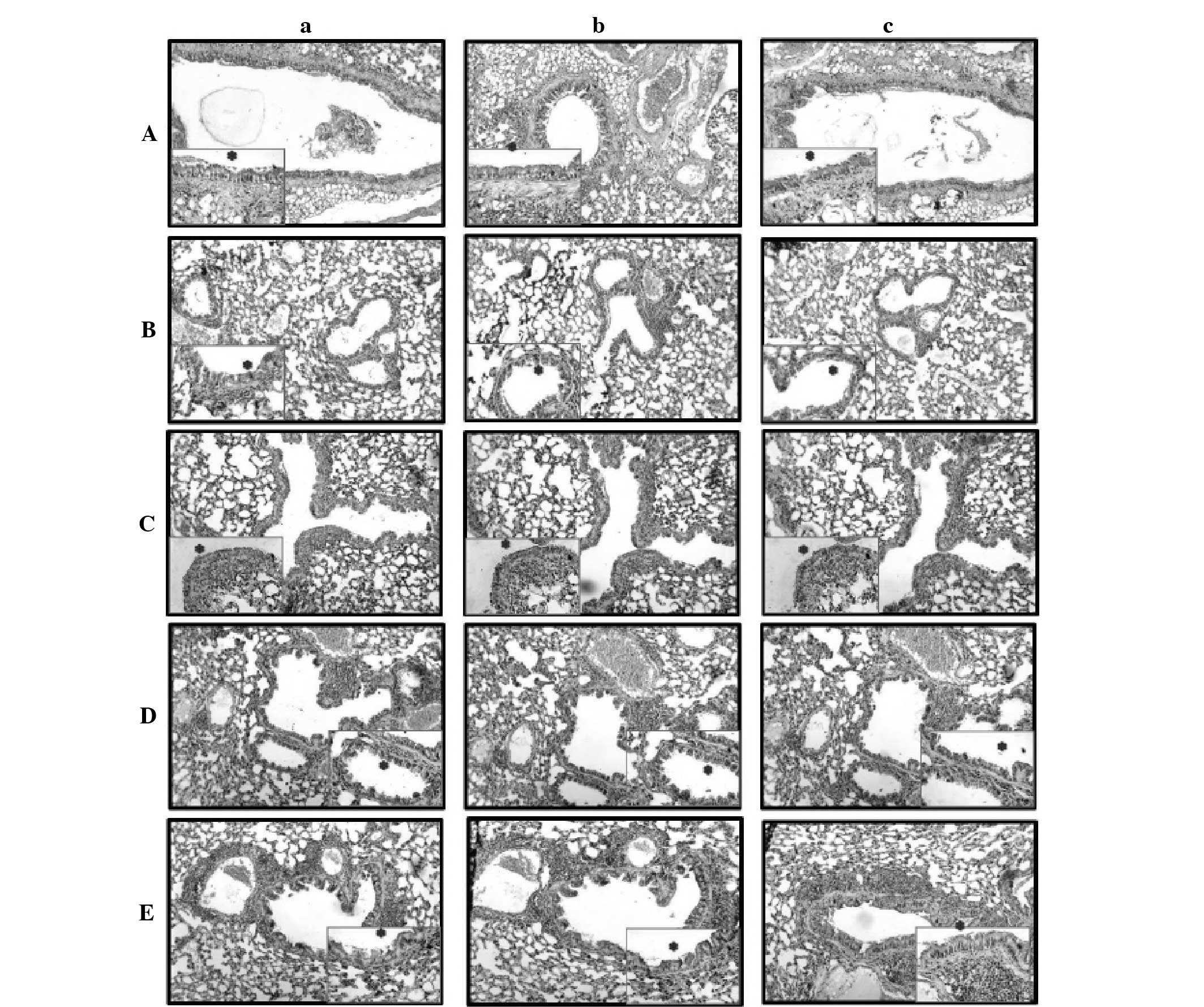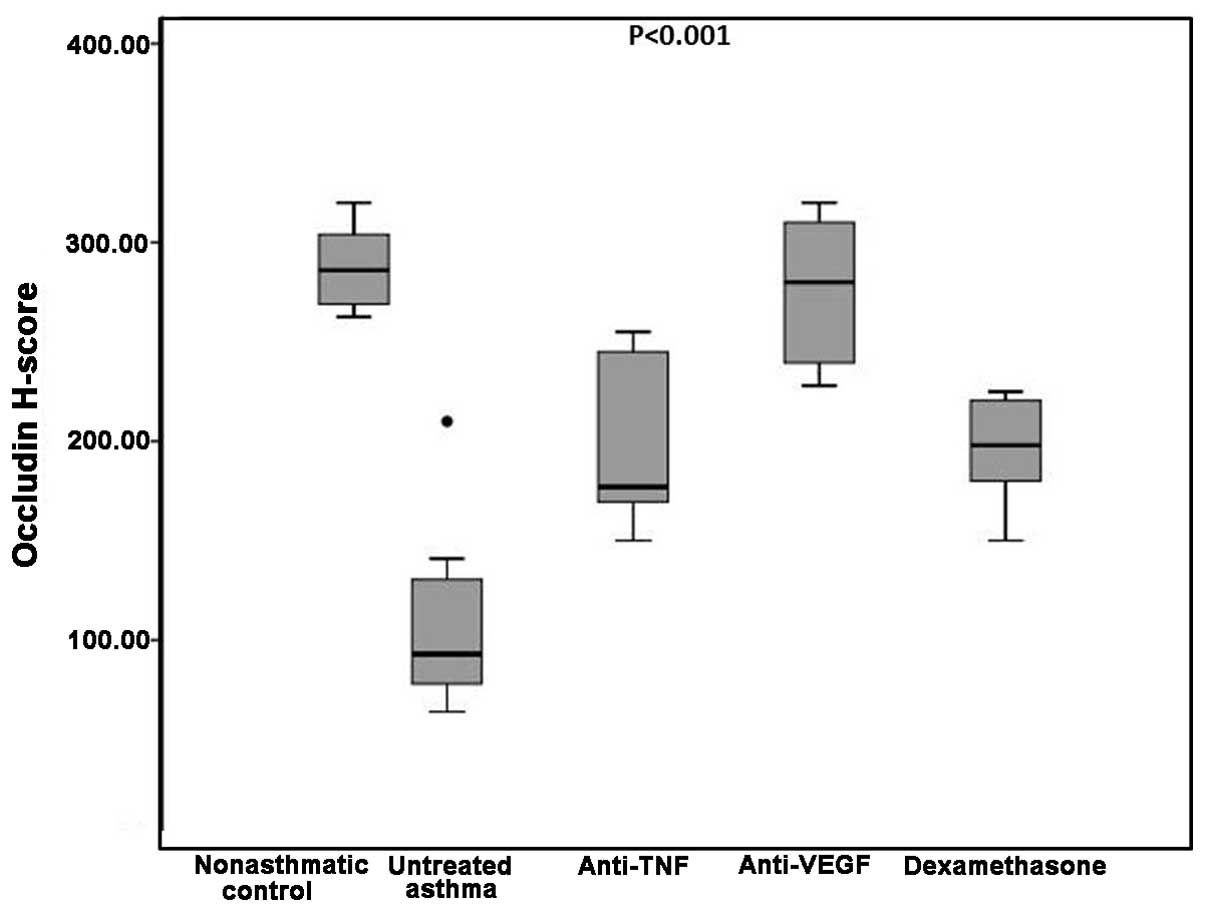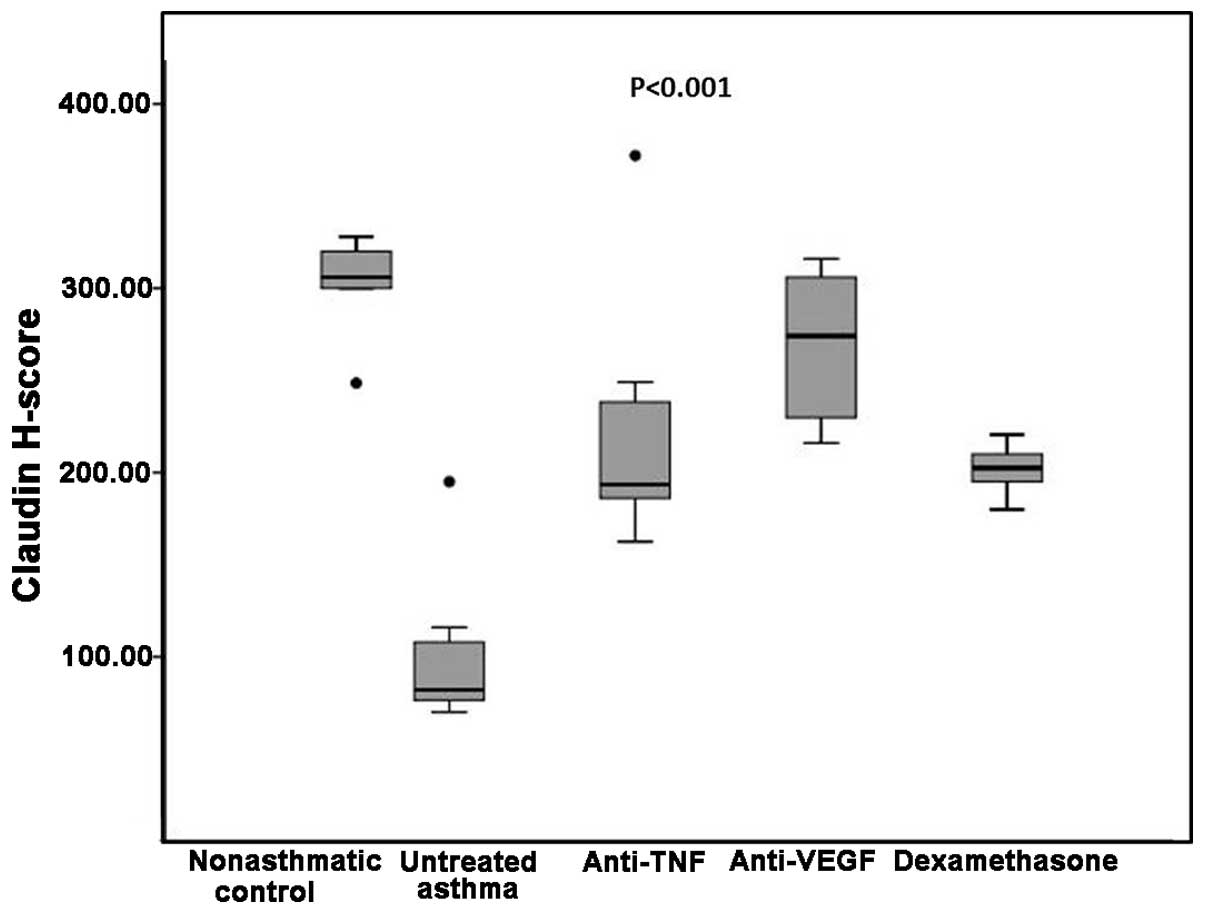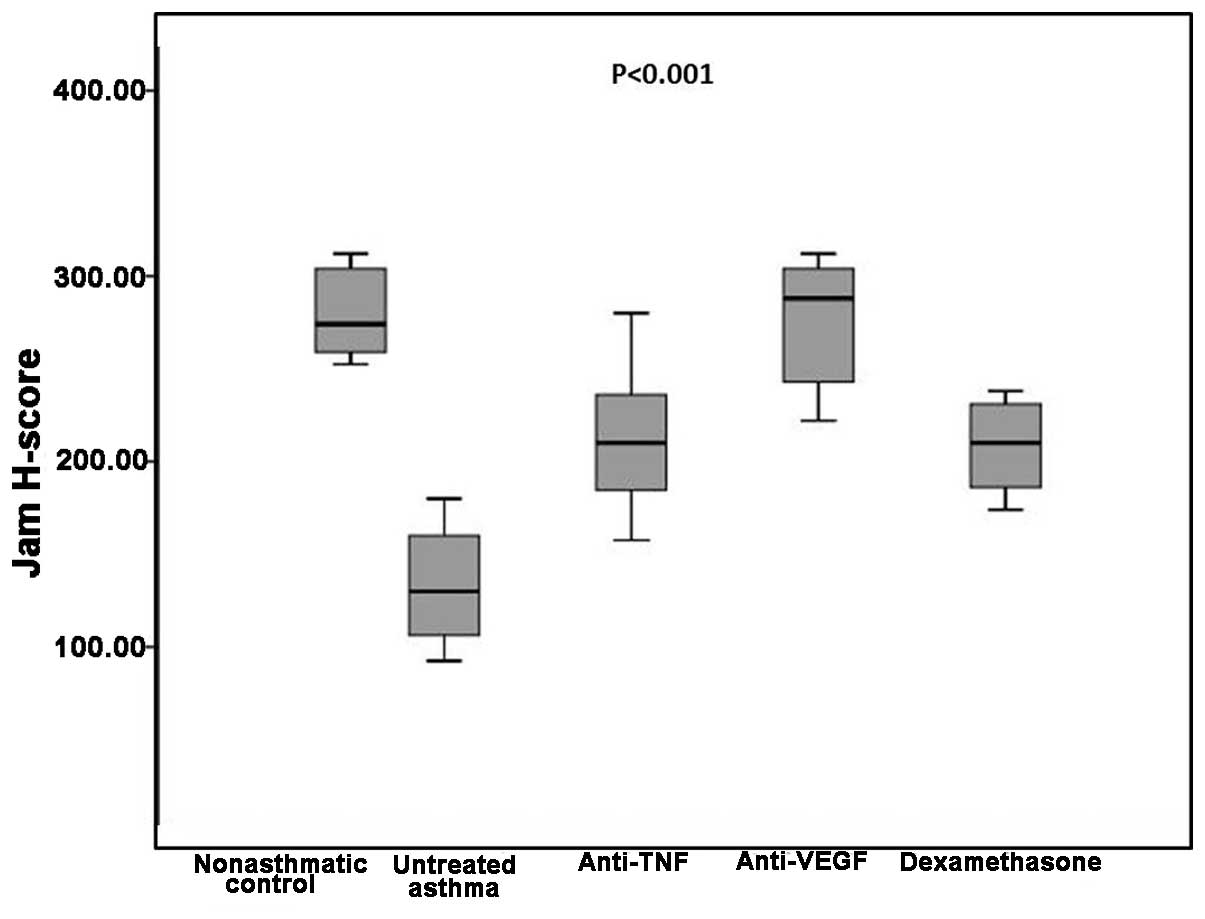|
1
|
Holgate ST: Epithelium dysfunction in
asthma. J Allergy Clin Immunol. 120:1233–1244. 2007. View Article : Google Scholar : PubMed/NCBI
|
|
2
|
Marchiando AM, Graham WV and Turner JR:
Epithelial barriers in homeostasis and disease. Annu Rev Pathol.
5:119–144. 2010. View Article : Google Scholar : PubMed/NCBI
|
|
3
|
Daugherty BL, Mateescu M, Patel AS, Wade
K, Kimura S, Gonzales LW, Guttentag S, Ballard PL and Koval M:
Developmental regulation of claudin localization by fetal alveolar
epithelial cells. Am J Physiol Lung Cell Mol Physiol.
287:L1266–L1273. 2004. View Article : Google Scholar : PubMed/NCBI
|
|
4
|
Förster C: Tight junctions and the
modulation of barrier function in disease. Histochem Cell Biol.
130:55–70. 2008. View Article : Google Scholar : PubMed/NCBI
|
|
5
|
Xiao C, Puddicombe SM, Field S, Haywood J,
Broughton-Head V, Puxeddu I, Haitchi HM, Vernon-Wilson E, Sammut D,
Bedke N, Cremin C, Sones J, Djukanović R, Howarth PH, Collins JE,
Holgate ST, Monk P and Davies DE: Defective epithelial barrier
function in asthma. J Allergy Clin Immunol. 128:549–556. 2011.
View Article : Google Scholar : PubMed/NCBI
|
|
6
|
Aslam M, Ahmad N, Srivastava R and Hemmer
B: TNF-α induced NFκB signaling and p65 (RelA) overexpression
repress Cldn5 promoter in mouse brain endothelial cells. Cytokine.
57:269–275. 2012. View Article : Google Scholar : PubMed/NCBI
|
|
7
|
Bruewer M, Luegering A, Kucharzik T,
Parkos CA, Madara JL, Hopkins AM and Nusrat A: Proinflammatory
cytokines disrupt epithelial barrier function by
apoptosis-independent mechanisms. J Immunol. 171:6164–6172. 2003.
View Article : Google Scholar : PubMed/NCBI
|
|
8
|
Cui W, Li LX, Sun CM, Wen Y, Zhou Y, Dong
YL and Liu P: Tumor necrosis factor alpha increases epithelial
barrier permeability by disrupting tight junctions in Caco-2 cells.
Braz J Med Biol Res. 43:330–337. 2010. View Article : Google Scholar : PubMed/NCBI
|
|
9
|
Coyne CB, Vanhook MK, Gambling TM, Carson
JL, Boucher RC and Johnson LG: Regulation of airway tight junctions
by proinflammatory cytokines. Mol Biol Cell. 13:3218–3234. 2002.
View Article : Google Scholar : PubMed/NCBI
|
|
10
|
Deissler HL, Deissler H, Lang GK and Lang
GE: VEGF but not PIGF disturbs the barrier of retinal endothelial
cells. Exp Eye Res. 115:162–171. 2013. View Article : Google Scholar : PubMed/NCBI
|
|
11
|
Antonetti DA, Barber AJ, Khin S, Lieth E,
Tarbell JM and Gardner TW: Penn State Retina Research Group:
Vascular permeability in experimental diabetes is associated with
reduced endothelial occludin content: Vascular endothelial growth
factor decreases occludin in retinal endothelial cells. Diabetes.
47:1953–1959. 1998. View Article : Google Scholar : PubMed/NCBI
|
|
12
|
Deissler HL, Deissler H and Lang GE:
Actions of bevacizumab and ranibizumab on microvascular retinal
endothelial cells: Similarities and differences. Br J Ophthalmol.
96:1023–1028. 2012. View Article : Google Scholar : PubMed/NCBI
|
|
13
|
Sekiyama A, Gon Y, Terakado M, Takeshita
I, Kozu Y, Maruoka S, Matsumoto K and Hashimoto S: Glucocorticoids
enhance airway epithelial barrier integrity. Int Immunopharmacol.
12:350–357. 2012. View Article : Google Scholar : PubMed/NCBI
|
|
14
|
National Research Council: Committee for
the Update of the Guide for the Care and Use of Laboratory
AnimalsGuide for the Care and Use of Laboratory Animals. 8th.
Washington (DC), USA: National Academies Press; 2011
|
|
15
|
Temelkovski J, Hogan SP, Shepherd DP,
Foster PS and Kumar RK: An improved murine model of asthma:
Selective airway inflammation, epithelial lesions and increased
methacholine responsiveness following chronic exposure to
aerosolised allergen. Thorax. 53:849–856. 1998. View Article : Google Scholar : PubMed/NCBI
|
|
16
|
Yuksel H, Yilmaz O, Baytur YB and Ozbilgin
K: Prenatal administration of granulocyte-macrophage
colony-stimulating factor increases mesenchymal vascular
endothelial growth factor expression and maturation in fetal rat
lung. Exp Lung Res. 34:550–558. 2008. View Article : Google Scholar : PubMed/NCBI
|
|
17
|
Lambrecht BN and Hammad H: Asthma: The
importance of dysregulated barrier immunity. Eur J Immunol.
43:3125–3137. 2013. View Article : Google Scholar : PubMed/NCBI
|
|
18
|
Holgate ST: Pathogenesis of asthma. Clin
Exp Allergy. 38:872–897. 2008. View Article : Google Scholar : PubMed/NCBI
|
|
19
|
Holgate ST: The sentinel role of the
airway epithelium in asthma pathogenesis. Immunol Rev. 242:205–219.
2011. View Article : Google Scholar : PubMed/NCBI
|
|
20
|
Felinski EA, Cox AE, Phillips BE and
Antonetti DA: Glucocorticoids induce transactivation of tight
junction genes occludin and claudin-5 in retinal endothelial cells
via a novel cis-element. Exp Eye Res. 86:867–878. 2008. View Article : Google Scholar : PubMed/NCBI
|
|
21
|
Harhaj NS, Felinski EA, Wolpert EB,
Sundstrom JM, Gardner TW and Antonetti DA: VEGF activation of
protein kinase C stimulates occludin phosphorylation and
contributes to endothelial permeability. Invest Ophthalmol Vis Sci.
47:5106–5115. 2006. View Article : Google Scholar : PubMed/NCBI
|
|
22
|
Yuksel H, Kose C, Yilmaz O, Ozbilgin K,
Degirmenci PB, Pinar E and Kirmaz C: Increased expression of tissue
vascular endothelial growth factor and foetal liver kinase-1
receptor in seasonal allergic rhinitis and relevance to asthma
component. Clin Exp Allergy. 37:1183–1188. 2007. View Article : Google Scholar : PubMed/NCBI
|
|
23
|
Hardyman MA, Wilkinson E, Martin E,
Jayasekera NP, Blume C, Swindle EJ, Gozzard N, Holgate ST, Howarth
PH, Davies DE and Collins JE: TNF-α-mediated bronchial barrier
disruption and regulation by src-family kinase activation. J
Allergy Clin Immunol. 132:665–675. 2013. View Article : Google Scholar : PubMed/NCBI
|
|
24
|
Yamada H, Yoneda M, Inaguma S, Watanabe D,
Banno S, Yoshikawa K, Mizutani K, Iwaki M and Zako M: Infliximab
counteracts tumor necrosis factor-α-enhanced induction of matrix
metalloproteinases that degrade claudin and occludin in
non-pigmented ciliary epithelium. Biochem Pharmacol. 85:1770–1782.
2013. View Article : Google Scholar : PubMed/NCBI
|
|
25
|
Arnett HA and Viney JL: Considerations for
the sensible use of rodent models of inflammatory disease in
predicting efficacy of new biological therapeutics in the clinic.
Adv Drug Deliv Rev. 59:1084–1092. 2007. View Article : Google Scholar : PubMed/NCBI
|


















